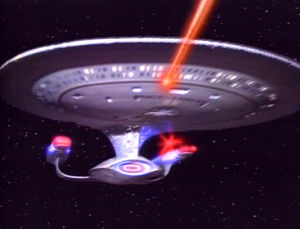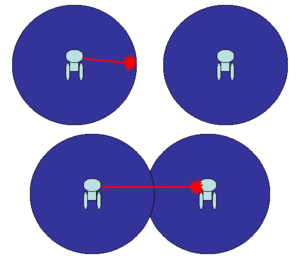Difference between revisions of "Starship phasers"
PicardAlpha (talk | contribs) (→Range) |
PicardAlpha (talk | contribs) (→Range) |
||
| Line 29: | Line 29: | ||
[[Image:Warp fields.gif|thumb|right|Warp field interaction may restrict range at FTL speeds.]]The [[ST_weapon_accuracy_and_range|range]] of starship phasers is difficult to determine, largely because examples tend to be contradictory. When seen on screen, hostile ships invariably close to within a few kilometers of each other before exchanging phaser fire. | [[Image:Warp fields.gif|thumb|right|Warp field interaction may restrict range at FTL speeds.]]The [[ST_weapon_accuracy_and_range|range]] of starship phasers is difficult to determine, largely because examples tend to be contradictory. When seen on screen, hostile ships invariably close to within a few kilometers of each other before exchanging phaser fire. | ||
Dialogue often suggests far greater ranges (as much as | Dialogue often suggests far greater ranges (as much as [http://startrek-vs-starwars.freeoda.com/startrek-vs-starwars/star_trek/space/starship_tactical_systems/phasers.html 190 000 km] in [[TNG]] "The Phoenix") but sometimes indicates much lower ranges (as little as 500 meters for optimum effect in [[DS9]] "The Die is Cast"), althought these are not standard "beam", put rather pulse phasers. | ||
From a practical standpoint, ships using lightspeed beam weapons against each other won't be able to engage while using faster-than-light propulsion systems unless the "warp field" generated by the attacker's engines either extends far enough to enclose the target or interacts with the target's own warp field to create a "free fire" path between the two ships. | From a practical standpoint, ships using lightspeed beam weapons against each other won't be able to engage while using faster-than-light propulsion systems unless the "warp field" generated by the attacker's engines either extends far enough to enclose the target or interacts with the target's own warp field to create a "free fire" path between the two ships. | ||
Revision as of 16:26, 15 January 2011
Starship phasers are the primary weapons used by the Starfleet of the United Federation of Planets. They use the same operating principles as hand-phasers, but they are much more powerful.
Firepower
The phasers on a Galaxy-class starship can deliver at least a terawatt of power. Because phasers create chain reactions in their targets, the damage they inflict can be disproportionate to the energy delivered.
Firepower Examples
- TNG "Who Watches the Watchers"
- 4.2 GW of power will supply a small phaser bank. What constitutes a "small" phaser bank is unclear.
- TNG "Best of Both Worlds, Pt 1"
- The power output of the Enterprise's weapons -- including phasers -- is far less than the potential output of its main deflector dish.
- TNG "Night Terrors"
- A deflector dish blast releases less energy than the exothermic chemical reaction of hydrogen and another exotic compound. Consequently, the output of the ship's phasers must also be less.
- TNG "A Matter of Time"
- A high-power burst from the phasers can be difficult to control to within a 0.06 TW (60 GW) tolerance, indicating that TW-range output is possible but control is limited at such high power levels.
- TNG "The Survivors"
- In an early appearance, an illusory Husnock warship fires on the Enterprise using anti-matter bursts with an "equivalent firepower" of 40 MW (presumably equivalent to a 40 MW phaser); the crew considers these bursts essentially harmless. In a subsequent appearance, the Husnock ship fires 400 GW bursts that cause extensive damage and clearly surprise the crew. Presumably the weapons of the Enterprise and other Alpha Quadrant warships typically operate somewhere between these extremes.
- Star Trek: Insurrection
- A chemical explosion of low-density metryon gas is more effective as a weapon than the Enterprise-E's phasers and quantum torpedoes. Prior loss of the warp core probably affects phaser power, however.
- ST:TNG Technical Manual (not a canon source)
- The power output of the Enterprise's phaser arrays is 1.02 GW.
Range
The range of starship phasers is difficult to determine, largely because examples tend to be contradictory. When seen on screen, hostile ships invariably close to within a few kilometers of each other before exchanging phaser fire.
Dialogue often suggests far greater ranges (as much as 190 000 km in TNG "The Phoenix") but sometimes indicates much lower ranges (as little as 500 meters for optimum effect in DS9 "The Die is Cast"), althought these are not standard "beam", put rather pulse phasers.
From a practical standpoint, ships using lightspeed beam weapons against each other won't be able to engage while using faster-than-light propulsion systems unless the "warp field" generated by the attacker's engines either extends far enough to enclose the target or interacts with the target's own warp field to create a "free fire" path between the two ships.
The use of lightspeed weapons and sensors may also affect range, as sensor lag will reduce accuracy as range increases. A target a light-second away from the attacker may move a ship-length or more in the amount of time it takes a burst from a beam weapon to propagate to the target, causing a miss. The attacker could compensate by predicting the target's position, but evasive maneuvers would make such predictions unreliable. At shorter ranges, a target simply won't be able to move very far in the propagation time of the beam.
Distribution
A Galaxy-class Federation starship primarily relies on two phaser arrays, a dorsal array atop the saucer section and a ventral array on the bottom of the saucer.
In one of the most ridiculed FX goofs in Star Trek history, the ship's phasers were once seen to emerge from the forward torpedo tube of the ship's drive section in TNG "Darmok".


